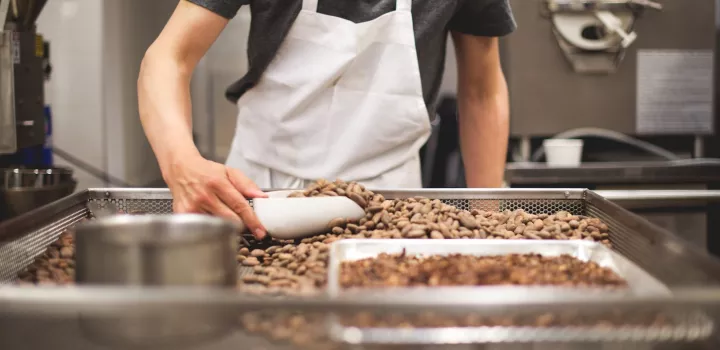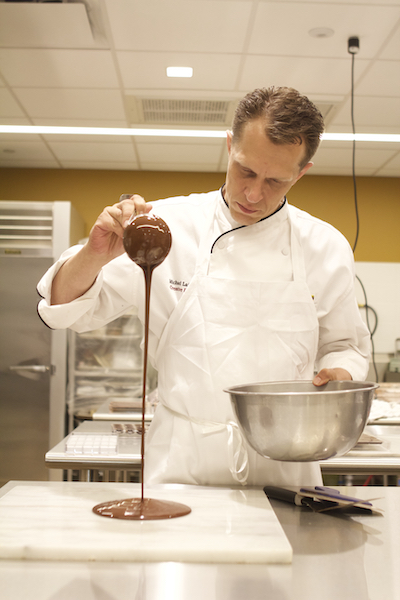
Chocolate Classes Return to ICE's Bean-to-Bar Lab
Study with Award-Winning Pastry Chef Michael Laiskonis
The deep aroma of roasted cacao beans and the familiar hum of the chocolate machines are back. Though much of the activity in the Institute of Culinary Education bean-to-bar Chocolate Lab was idle for the past year, public-facing educational programs return in August.
The Chocolate Lab’s origin story dates back nearly nine years when ICE began to outgrow its New York campus on West 23rd Street. The initial seed of an idea — perhaps carving out a small corner of a kitchen classroom dedicated to chocolate and confectionery projects — soon blossomed into a forward-thinking blueprint to study chocolate on a deeper level. When launched with the completion of the new campus at Brookfield Place in 2015, the lab offered a unique opportunity to provide hands-on experiences in manufacturing chocolate from raw bean to finished bar. Giving visibility to the chocolate-making process enhanced the material studied in our career Pastry & Baking Arts program and offered classes designed for curious chocolate lovers and aspiring makers alike.
The chocolate-making process, on its surface, is fairly simple. Raw cacao is roasted, the beans’ outer shells removed and the remainder crushed into the nibs. Those nibs are then ground and further refined with the addition of sugar and perhaps some cocoa butter. Each basic step of the process presents any number of variabilities, and any single step could be performed by a variety of machines that will contribute, in part, to the characteristics of finished chocolate. The suite of machines lined up in the Chocolate Lab include a drum roaster, winnower, hammer mill (which pre-grinds nibs into a paste known as "liquor"), cocoa butter press and temperature-controlled ball mill. Outfitted with equipment originally designed for research-scale production by large manufacturers, the lab’s capabilities allow for batches up to 25 pounds.
Over five years, a range of regular courses were created, and the lab found a place within the diverse network of artisan makers, academics and chocolate aficionados. A familiar story by now, the initial surge of COVID-19 shuttered schools like ICE, and the Chocolate Lab entered a period of hibernation. Amid strict safety protocols, career training programs resumed, but many of the public programs, from recreational classes to professional development studies, were halted out of caution. The time has now come to reopen the lab, and I’m excited to be reorganizing the space and giving all of the equipment a tune-up in anticipation of our first round of classes this summer.
The series kicks off on Aug. 4, with a rebooted version of our exploratory look at the chocolate-making process. A Bean-to-Bar Chocolate Experience offers a four-hour tour of the lab and an overview of chocolate from farm to factory. Curious chocolate lovers will gain a broad insight into the various factors that give chocolate its taste and will briefly touch each part of the process before sitting down to a comparative tasting of bars made onsite to further elaborate on these ideas. A companion class, Beyond Bean-to-Bar: Fundamental Chocolate Techniques, returns on Sept. 9 and will cover basic skills like tempering and using craft chocolate in a variety of pastry and confectionery applications.
A second-level course for those seeking hands-on skills, A Bean-to Bar Chocolate Intensive, is a two-day program taking place Oct. 9-10. This class offers professionals and enthusiastic amateurs an opportunity to touch, smell and taste chocolate throughout the process to better understand the complex cause and effect of each step. The extended format allows the production of a few simple batches, which attendees will temper, mold and take home at the end of class.
 And finally, for a deeper dive, A Bean-to-Bar Chocolate Immersion will convene Nov. 1-4. This four-day course offers a more detailed look into sourcing cacao, agricultural aspects, genetics, flavor chemistry and the complex physics at work in the manufacturing of chocolate. Multiple batches from start to finish will compare origin, formulation and style. This popular course also introduces concepts relevant to chocolate as a business. The intimate class setting also allows for an exchange of information and experience among the students over an immersive 24 hours of lab time.
And finally, for a deeper dive, A Bean-to-Bar Chocolate Immersion will convene Nov. 1-4. This four-day course offers a more detailed look into sourcing cacao, agricultural aspects, genetics, flavor chemistry and the complex physics at work in the manufacturing of chocolate. Multiple batches from start to finish will compare origin, formulation and style. This popular course also introduces concepts relevant to chocolate as a business. The intimate class setting also allows for an exchange of information and experience among the students over an immersive 24 hours of lab time.
I sometimes joke that the more I learn about chocolate, the more I realize what I don’t know. The only thing I enjoy more than the personal discovery is sharing what I’ve learned with others. Though the physical space of the Chocolate Lab has sat quietly these past months, I’ve only intensified my own study, and I can’t wait to inform and inspire once again as we welcome students back.
Get hands-on with Chef Michael in the Chocolate Lab.


Add new comment